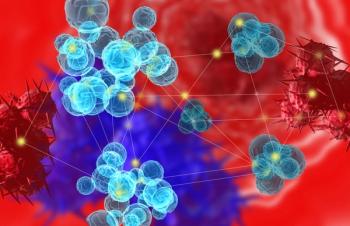
Grade I to IIA, Transformed Follicular Lymphoma Show Positive Antitumor Response to Glofitamab
In a phase 1 trial, the recommended phase 2 dose of glofitamab resulted in frequent and durable complete responses for patients with follicular lymphoma and transformed diffuse large B-cell lymphoma arising from follicular lymphoma.
The T-cell–engaging bispecific antibody glofitamab induced response rates above 50% in patients with both relapsed or refractory follicular lymphoma (FL) and diffuse large B-cell lymphoma (DLBCL) arising from FL, according to results of the phase 1 NP30179 clinical trial (NCT03075696).
The objective response rate (ORR) in patients with grade I to IIIA FL (n = 44) was 70.5% (95% CI, 54.8%-83.2%), made up of 21 complete and 10 partial responses (PRs); in those with transformed FL (trFL; n = 29), the ORR was 55.2% comprised of 10 complete responses (CRs) and 6 partial responses.
The patient population (n = 171) on the study also included patients with other forms of non-Hodgkin lymphoma (NHL), such as DLBCL (n = 73) and Richter transformation from chronic lymphocytic leukemia (n = 10).
In the aggressive NHL group, which included patients with transformed FL, the median duration of response was 5.5 months (95% CI, 4.4-not estimable [NE]; range 0.8-28.8) and the median duration of CR was not reached (range, 0.0-27.4). In this group, the median progression-free survival was 2.9 months (95% CI, 2.1-3.9), with a plateau occurring at about 8 months of approximately 24%. Among all aggressive NHL subtypes, the ORR was 48.0% with 33.1% CRs.
In the grade I to IIIA FL group, the median duration of response was 10.8 months (95% CI, 3.9-NE) and the median progression-free survival was 11.8 months (95% CI, 6.3-24.2). The median duration of CR was not reached, with 19 of 21 patients maintaining their response up to 22.9 months.
Based on safety and pharmacokinetic/dynamic data, the recommended phase 2 dose (RP2D) was selected as a step-up dosing regimen of glofitamab at 2.5 mg on day 1 or cycle 1, 10 mg on day 8 of cycle 1, and 30 mg on day of cycle 2. The 21 patients with FL receiving the RP2D had an ORR of 61.9%, made up of 11 CRs. Of 3 patients with trFL receiving the RP2D, the ORR and CR rates were both 100%.
In the entire cohort, patients were a median age of 64 years (range, 22-85), with 62% being over the age of 60. About half (48.8%) had an ECOG performance score of 1 or 2. The median number of prior therapies was 3 (range, 1-13) and 90.6% were refractory to their prior therapy.
Adverse events (AEs) considered to be related to glofitamab occurred in 83.6% of patients. Cytokine release syndrome (CRS) was the most common AE, with 50.3% of patients experiencing grade 1, 21.6% with grade 2, 25.1% with grade 3, and 2.3% with grade 4 in severity. The median time to CRS onset and duration were 10.8 hours (range, 3.0-47) and 2.2 days (range, 0.0-31.0), respectively. The incidence of CRS increased in-step with higher doses, but declined significantly after the first administration, with 13.1% of participants experiencing events at cycle 2 and 6.1% at cycle 3 or later.
Glofitamab is an accessible “off-the-shelf” cellular therapy that differs from available chimeric antigen receptor T-cell agents in that it does not require manufacturing. It bivalently binds to CD20 on B cells and monovalently binds CD3 on T cells.
“This novel T-cell–engaging bispecific antibody has shown high levels of single-agent activity in [relapsed/refractory B-cell NHL],” wrote the study authors, who were led by Martin Hutchings, MD,PhD. “Glofitamab has demonstrated frequent, durable CRs and a manageable tolerability profile and allows off-the-shelf treatment for patients with refractory B-NHL in need of timely therapy.”
Reference
Hutchings M, Morschhauser F, Iacoboni G, et al. Glofitamab, a novel, bivalent CD20-targeting T-cell-engaging bispecific antibody, induces durable complete remissions in relapsed or refractory B-cell lymphoma: a phase I trial. J Clin Oncol. March 19, 2021. doi: 10.1200/JCO.20.03175
Newsletter
Stay up to date on recent advances in the multidisciplinary approach to cancer.

















































































